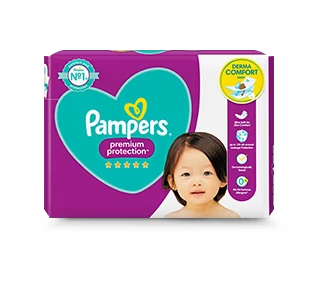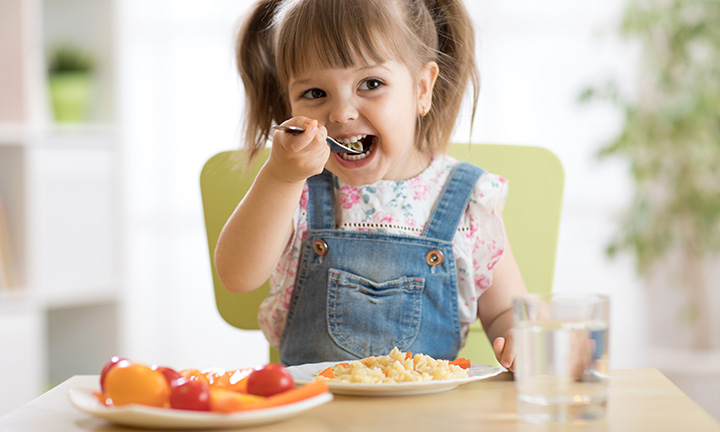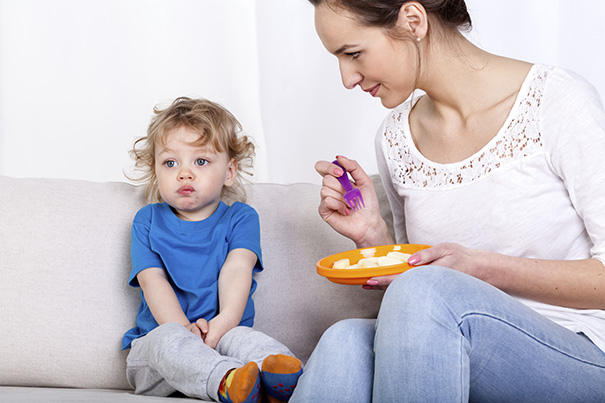
30 Healthy Snack Ideas for Toddlers
Experts agree that toddlers need one or two healthy snacks a day in addition to three child-sized meals. If you’ve run out of toddler snack ideas, we’ve got you covered!
Check out these 30 easy and healthy snack ideas for toddlers, plus get more tips on how to choose and serve nutritious and fun snacks for your toddler or older child.
30 Healthy Snacks for Toddlers
Healthy snacks can be fun for your toddler once you know what to include. Here are some ideas on what to serve up between meals, as an after-nursery-school snack or as a tasty addition to a lunchbox or picnic basket:
Breakfast cereal. Pour some in a cup for an afternoon snack. Your toddler may enjoy picking out the pieces one by one. Choose a wholegrain cereal that’s sugar-free or low in sugar. Add a dollop of plain, unsweetened yoghurt for extra flavour and dairy goodness.
Eggs. These are a great source of protein. Offer cut-up hard-boiled, poached or scrambled eggs or even an omelette cut into bite-sized pieces as a quick snack.
Fresh fruit. Whole fruits are great sources of vitamins, fibre and other nutrients. Give your toddler small slices of fresh, juicy peach, plum, apple, oranges, kiwi fruit, mango, banana or whatever else is ripe and in season. Be careful to remove any pips or stones before serving.
Apple sauce. This is another appealing way to incorporate fruit into your child’s diet, and a great accompaniment for bland-tasting foods like oatmeal. Buy the kind that has no added sugar or make your own apple sauce at home. Simply combine cubed, peeled apples with a tiny bit of water or lemon juice in a saucepan and cook on low heat until they’re soft enough to mash.
Cottage cheese. The lumpy texture could make this a fun snack for your toddler! Stir in some cut-up fruit or berries for some flavour, nutrients and crunch. When buying dairy products like cottage cheese for your toddler, always choose full-fat products at least until your child is 2 years old – reduced-fat variants don’t contain enough energy for your growing child.
Potatoes. Boiled and diced potatoes or sweet potatoes are a great healthy snack option. Don’t give your toddler chips with salt.
Breadsticks. A crunchy, unsalted breadstick has a great texture and is easy for your little one to hold. Dip it in hummus or yoghurt for extra flavour. Gnawing on a breadstick can also help ease your child’s teething symptoms.
Toast. Toast fingers or ‘soldiers’ (made from a healthy wholegrain bread) can be a versatile snack: spread a little butter or cream cheese on them or show your toddler how to dunk them in hummus, yoghurt or the yolk of a soft-boiled egg. For soft-boiled eggs, always use eggs stamped with the Red Lion mark, which have a low risk of carrying salmonella.
Cheese. Cheese fingers, cheese cubes, little smiley faces cut out of cheese – the possibilities are endless. Add some chunks of apple into the mix for a winning combination of contrasting flavours and textures. Cheese is a good source of calcium and protein.
Peanut butter. Choose the smooth kind and spread it thinly on wholegrain toast or bread – it’ll be a hit. Other nut butters are also a great choice. Just be sure to look out for the signs of an allergic reaction (like diarrhoea or vomiting, coughing, a rash, a swollen mouth or difficulty breathing) the first few times you give any new type of food.
Crumpets. A warm, buttered crumpet is a filling snack, especially on cold winter afternoons. Wholemeal is the healthiest option. Cut it into manageable bits or just in half to gnaw on. Spread with some cream cheese, smooth peanut butter or pureed fruit for extra deliciousness.
Rice or corn cakes. You may think of this as a bland health food snack, but children will love the crispy, crunchy texture. It’s also fun for your toddler to hold onto the big disk of puffed rice. Try spreading a little cream cheese or smooth peanut butter onto it for added flavour and nutrition.
Cheese on toast. A slice of wholemeal bread with some cheese sprinkled on top, then lightly grilled and cut into strips makes a delicious savoury teatime snack. Make sure you let the hot cheese cool down properly before serving it up.
Soft-cooked vegetables. Steamed or boiled broccoli, cauliflower, green beans and carrots can be fun snacks for children because of their shapes. Broccoli and cauliflower can be little ‘trees’ and green beans are great for making pictures or patterns on the plate.
Yoghurt. Plain unsweetened yoghurt with some fresh berries or cubes of peaches or plums stirred in makes a great snack.
Wholewheat pitta. Pitta strips can be really fun for your child to dip into hummus and eat.
Mashed peas or beans. Lightly mashed beans or peas can win over small children with vivid colours and a satisfyingly creamy texture.
Wholewheat pancakes. All you need for this children’s favourite is a little wholewheat flour, eggs and milk. These could be delicious rolled up with a cottage cheese or puréed fruit filling and chopped up into bite-sized morsels. You could also ask your toddler to help with mixing the ingredients for added fun.
Banana milkshake. Pop a banana into the blender, add some milk and whiz it all up for a frothy and filling calcium, vitamin and mineral-rich drink. If you don’t have a blender or food processor, put the ingredients in a bowl and use a hand mixer or a fork (to mash up the banana).
Cereal mix. Make your own child-friendly cereal mix by combining your child’s favourite sugar-free cereal, like cornflakes, with fresh berries or chunks of soft fruit.
Chicken. Don't overlook cold, leftover chicken as a great toddler snack idea that's packed with protein. Seared or baked chicken breast or other cuts with the bones removed can be a good choice for young children because they’re easy to chew. Just be sure to cut them into small pieces for your toddler.
Leftovers. If you’re cooking a large family meal, set aside any unwanted portions for use as snacks later on. You might even plan the quantities you cook deliberately like this to save time later. For example, if you’re having fish fingers, mash and veggies for supper, stick a couple of extra fish fingers under the grill. Even cold, they’ll make a fun snack for your toddler the next day.
Porridge. A breakfast food like porridge can do double duty as a snack for your child. Add a little cut-up fruit for some variety.
Rice pudding. What toddler could resist the milky flavour and creamy texture of rice pudding? Make it yourself or go for a sugar-free shop-bought variety. If your child doesn’t eat dairy products, it’s possible to make or buy rice pudding made with alternatives such as coconut milk.
Wholegrain crisps. Luckily, there are many good wholegrain and wholewheat crisps in the shops now. Look for ones with the least amount of added salt and sugar. Serve them plain or with hummus or mashed avocado for fun dipping.
Butternut squash. Cut up a butternut squash into pieces that can be held in a little hand, then bake them in the oven until soft. Make sure to let them cool down before giving them to your little one.
Sweet potato pudding. Roasted or boiled sweet potatoes mashed up with a little unsweetened plain yoghurt can be yummy either spooned into your toddler’s mouth or as a dip. This is also a great way of using up any sweet potato you might have left over after a main meal. In fact, this idea could really work with most leftover cooked veggies.
Mini wholemeal pizzas. Make your own pizza dough or buy a ready-made base and top with some veggies, meat and cheese. Let your child choose from some healthy toppings, and let them arrange them on the pizza base before it goes into the oven. You can serve the slices straight away or put some in the fridge for later.
Tuna spread. Whisk together some tinned tuna (in spring water, drained), about a tablespoon of mayonnaise and two teaspoons of full-fat yoghurt for a great dip or spread.
Fromage frais ice lollies. Surprise your toddler with a fun snack to keep them cool on a hot, sunny day. Simply pierce the lid of a small fromage frais pot and stand a lolly stick up in it. Place in the freezer until frozen, then remove the outer packaging for an instant mini lolly. Always supervise your child while they are eating ice lollies, and don’t let your toddler eat them while running or walking around.
12 Tips for Child-Friendly Snacking
Making healthy snack choices is just as important as offering your child nutritious main meals. Although the word ‘snack’ can have some negative associations – many people think of them as sugary or salty treats – healthy snacks are actually a crucial part of your toddler’s diet.
Here are some tips for choosing or making healthy, energising snacks that are both nutritious and tasty:
Resist stocking up on junk food. Everyone loves the occasional bag of crisps, chocolate bar or custard cream from time to time, but having lots of items like this in the house can be very tempting for your child (and for the whole family). To keep demands at bay, don’t stock your kitchen with sweets, biscuits and comfort food. If you've got a junk food drawer or shelf, get rid of it. Do your best to set a good example for your toddler by eating and enjoying healthy snacks yourself.
Avoid dried fruit between meals. Fresh fruit can make a great healthy snack, but the sugars in dried fruits like raisins or prunes can harm your child’s teeth. This is why experts advise only giving them to your toddler with meals rather than as snacks.
Go for wholegrains. Instead of offering white, overly processed foods, go for wholegrain choices, like wholegrain bread, pitta, cereal or tortillas. An example of a snack could be a slice of wholemeal bread topped with cheese or spread with hummus.
Choose lots of colours. Fruit and vegetables come in a wide variety of eye-popping colours that appeal to children. You could offer mini peppers in red, orange, and yellow, for example, or pieces of mango and avocado.
Repeat breakfast time. Who said that you can only eat breakfast in the morning? Breakfast foods can also make great snacks, and they’re quick to prepare. For some variety, try mixing up some fresh berries or other fruit with cereal or offering pieces of an omelette or scrambled eggs in bite-sized portions.
Give your child full-fat dairy until at least 2 years old. Low-fat milk, yoghurt and other dairy products don’t contain all the energy your toddler needs to grow and be active. After the age of 2, it’s OK to gradually introduce low-fat options as long as your child is a good eater and growing well.
Make snacks with fun shapes. Sometimes the appearance of the food can make the difference between whether it ends up in your toddler’s mouth or on the floor, especially if your child is a fussy eater. Use cookie cutters to create different fun shapes. Or, take some cut-up fruit and arrange the pieces on a plate to make a funny face or rainbow shape. Slices of hard-boiled egg make great eyes, green beans can make hair, slices of bell pepper make a great pair of ears, broccoli can stand in as the nose and sliced banana works as the mouth!
Set up a snacking area. Keep snack time to certain areas of the house, like the kitchen counter or table. It’s best not to serve up snacks in front of the TV, as the distraction can prevent your toddler from enjoying (or even noticing) what they are eating.
Offer choices for your older child. Consider allowing your toddler to pick their own snack from time to time from a selection you have at the ready. Stock the fridge with veggies that are enticing to grab and go, like mini peppers, cucumber sticks, etc. Have a bowl of fresh fruit on the kitchen counter.
Read package labels. With shop-bought snacks (or the ingredients you use), many items have ‘traffic-light’ colour-coded labels showing the quantities of fat, sugars, salt and so on. If you buy packaged snacks for your child, the more green or amber you see on the label, the better. It’s especially important to keep the levels of sugar and sodium (salt) to a minimum.
Keep snack time on time. It’s a good idea to restrict snacking to certain times during the day, so it won’t interfere with lunch or dinner. Avoid snacks two hours before meals so your child will be hungry enough to eat a filling and nutritious main meal.
Choose easy-to-pack snacks when on the go. When snack time might occur during an errand or visit to the park, pack your toddler a snack. Snacks that you can fit into a lunchbox, sealable tub or resealable bag are the easiest choices. Individually wrapped items – like small wax-sealed cheeses, yoghurts or sugar-free cereal bars – are great when you’re out and about. Some foods – like hard-boiled eggs, clementines or bananas – even come with their own built-in packaging.
Foods to Avoid Giving Your Toddler
The following foods can be choking hazards for children under the age of 5, so avoid them at this stage:
Whole nuts and peanuts
Raw jelly cubes
Whole grapes, whole cherry tomatoes, whole cherries with stones
Boiled sweets, jelly beans, lollipops and other hard sweets
Chewing and bubble gum
Popcorn
Seeds (such as pumpkin seeds or sunflower seeds)
Large chunks of any food, such as meat or potatoes.
Sugar
Sugary drinks and snacks (including fruit juice) can lead to tooth decay. The best drinks for your toddler are water and milk.
If you do give your child fruit juice or smoothies, experts advise only giving them with food at mealtimes and diluting them (about 1 part juice to 10 parts water) until your little one is at least 5 years old.
Salt
Too much salt isn’t good for little kidneys. When you’re cooking for your family (if your toddler or small child will eat the same food), keep in mind that some ingredients, like stock cubes or powdered gravy, can be high in salt.
Other salty foods to avoid include:
Bacon
Sausages
Salted chips
Crackers
Most ready-to-eat meals
Takeaway food.
Certain Cheeses and Dairy Products
Unpasteurised dairy products and mould-ripened soft cheese like camembert or brie, as well as soft blue-veined varieties like Roquefort, aren’t recommended for babies and young children as they can sometimes contain listeria, a kind of bacteria that may cause food poisoning.
Raw and Partly Cooked Eggs
Hens' eggs with a red lion stamped on them have a low salmonella risk and are OK for your toddler or older child to eat uncooked as an ingredient in food (such as a homemade mayonnaise), or lightly cooked (for example, soft-boiled eggs).
Any other eggs should be cooked thoroughly all the way through to avoid the risk of salmonella food poisoning.
The Bottom Line
Planning your child’s snacks doesn’t have to be a chore if you keep things like healthy fruits, vegetables, cheese, eggs and spreads on hand.
Setting aside (or intentionally making) leftovers is another way of saving a little time the next time your hungry toddler needs a snack to tide them over between meals.
And if the snacks are fun as well as healthy, you’ll keep your little one topped up with energy and keep a smile on their face. Bon appétit!
How we wrote this article The information in this article is based on the expert advice found in trusted medical and government sources, such as the National Health Service (NHS). You can find a full list of sources used for this article below. The content on this page should not replace professional medical advice. Always consult medical professionals for full diagnosis and treatment.
- NHS: Over 12 months
- NHS: Baby and toddler meal ideas
- NHS: Baby and toddler safety
- NHS: Foods to avoid giving babies and young children
- NHS: Tips for helping your teething baby
- NHS: Green mash recipe
- NHS: Tuna dip recipe
- NHS: What to feed young children
- NHS: Healthier snacks for kids
- NHS: Healthier Food Swaps
- NHS: Drinks and cups for babies and young children
Read more about Toddler
Related Articles
Join Pampers Club and get:









